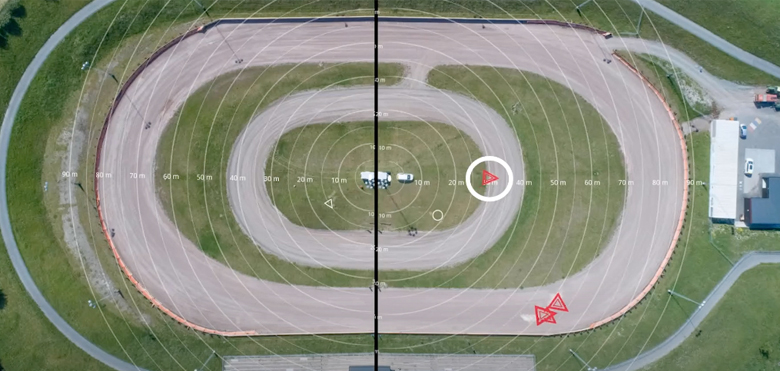How radar technology adds value to surveillance solutions
It’s true that one size doesn’t fit all, and this also applies to security solutions. Video surveillance is an important factor when it comes to protecting premises and sites – but not every solution fits every surrounding. Factors such as the size of the premises, the level of lighting, the presence of hazards or privacy regulations can present challenges which must be addressed to ensure effective security. When faced with vast perimeters and dark surroundings, there are several cameras and security solutions to choose from and for organisations it might be worth to discuss whether a combination of different technologies may be better suited to meet their needs – or simply something you might not have considered. One of the technologies that has a number of benefits, and, therefore, useful in a variety of environments is radar. This post looks at how three use cases as diverse as a public swimming pool in Sweden, a Brazilian car park and a chemical factory in Spain see the benefits of radar in safety and security to tackle their individual challenges.
One solution doesn’t fit all
Radar technology – firstly used for military purposes to detect aggressors on land, sea and in the air – has been a crucial addition to today’s security and surveillance sector. Its capability of detecting objects and people based on radio waves allows the device to ‘see’ even in challenging environments. This technology is highly useful to keep a variety of premises safe and secure – be that factories, public institutions like swimming pools or parking lots. For each of these examples, radars provide particular benefits that visual cameras don’t.
Protecting premises and privacy
Certain establishments are in the position where they need to protect their sites against intruders and criminals while still having to take visitors’ privacy into account. For a public pool, for instance, visual cameras may not be the optimal choice for surveillance.
This challenge was faced by a small town in Sweden that built a large outdoor public swimming pool in their center. It quickly became a popular spot for the residents during the summer – with some attempting to access the premises outside the opening hours. They had several cases of intruders entering the premises unattended, creating a risk to their health and safety. The property was also often damaged and littered. Not only did the town need to pay for the repairs and cleaning but during the cleaning process, the pool had to be closed to the public. Due to limited staff resources, the assigned security guards only patrolled the premises on one occasion during night time, which proved to be insufficient.
By installing only a single radar, the whole area around the pool was covered and an alarm was sent to the security guards if motion was detected. The guards could then verify the alarm via the radar view with object classification and take further actions if necessary. Due to its nature, the radar performance wasn’t affected by light conditions and worked perfectly during the night when it was needed the most. And as radar doesn’t deliver ‘visual camera images’, visitors wearing bathing suits didn’t have to worry about a violation of their privacy and the solution stayed GDPR compliant. After the installation, the number of incidents dropped rapidly, keeping citizens safe and saving the town the costs of sanitation and repairs.
Seeing the wood – or criminals – for the trees
In some cases, where the premises are harder to monitor and quick reactions are necessary to prevent crimes it can be useful to combine several features into one surveillance system. Perimeters don’t have to be vast to be difficult to monitor. Sometimes it’s enough if they are crowded or offer too many dark corners for criminals to hide, such as car parks.
If you parked your car in a designated parking area, wouldn’t you feel safer knowing that a surveillance system was in place to provide certain protection and criminal deterrence? One of the biggest universities in Brazil had the same thinking for their parking lot. Vehicles were often parked during the night and an increased number of break-ins and car thefts were reported. Limited budgets, staff shortages and difficulties in spotting criminals between the many cars and hedges presented significant challenges. To address issues around visibility and support staff, a solution which combined radar technology, horn speakers and visual cameras was implemented. During opening hours, radar and cameras detected and recorded movements only, which could offer insights in the case of an incident. At night, this was combined with the speakers which could be triggered by radar-detected movement to play pre-recorded audio clips to deter criminals. Simultaneously, security guards were alerted to investigate the situation remotely via mobile devices and take immediate actions.
The combination of radar and horn speakers deterred many criminals from breaking into cars parked on the premises. Plus, the surveillance footage (through combination with the cameras) served local police in their investigations.
A second security line for critical infrastructure
In certain sectors, it’s not only challenges that vary but also the level of protection that’s necessary or even mandatory. When it comes to critical infrastructure, gaps in the security systems are not an option. This becomes even more crucial if the premises are located in a suburban area, where there is a risk to the safety of residents and staff if an incident occurs.
A chemical factory was located in a suburban area and due to the nature of the substances handled on the premises, they had layers of security in place, including thermal cameras along the fence line. Yet, the number of targeted break-ins and intrusions grew as the area became more populated over the years. Unfortunately, the existing solution caused several false alarms that required security resources to constantly verify these alerts.
The implementation of radar built the second line of defense. It automatically triggered the existing cameras if a breach of the first line was detected, which then followed the movement of the intruder or object. This way, relevant footage of all incidents was captured by PTZ cameras from the moment an incident was registered by the radar. Determining the location of detected objects helped the security guards to respond faster and be better prepared. Thanks to the combination with PTZ cameras, security guards only needed to access the video feed to be able to assess the situation. As the full course of events of the incident was shown, no manual edits were required.
A subtle, reliable and (cost) effective technology
Radar – be that on its own or in combination with visual camera systems – can be effective in tackling several surveillance challenges. That’s thanks to several factors, including its ability to provide surveillance information regardless of the levels of lighting, compliance with privacy regulations and ability to detect objects in very large areas. Plus, radar technology can be combined with other devices as the premises or new security challenges demand. As shown in the previous examples, using an approach that utilizes radar is highly effective in crime prevention and protection. The options of radar are numerous and its application flexible. It’s time for organisations to consider integrating this technology into their surveillance solutions, so they can take advantage of the many benefits it confers.
To learn more about radar technology, follow this link:




